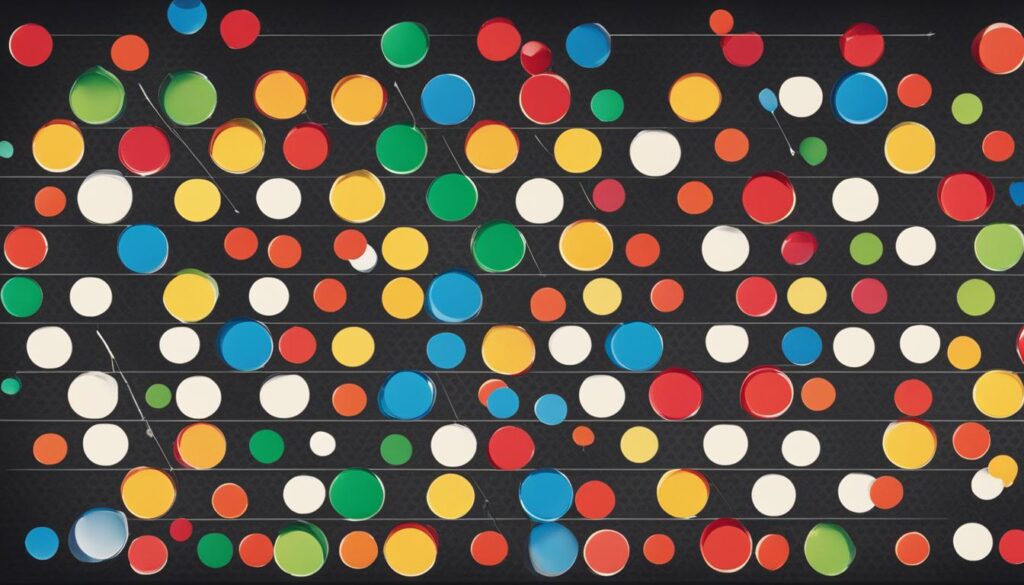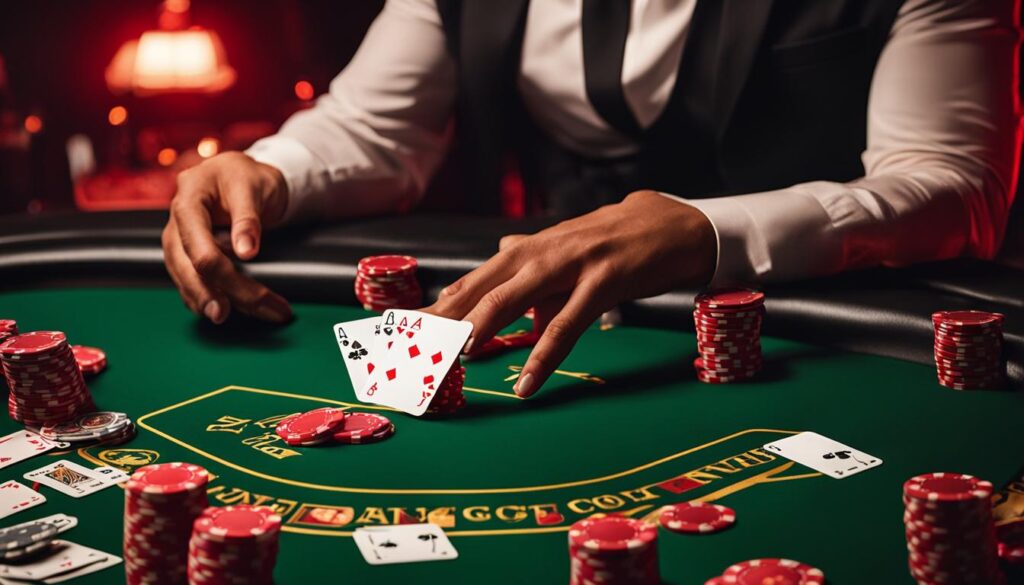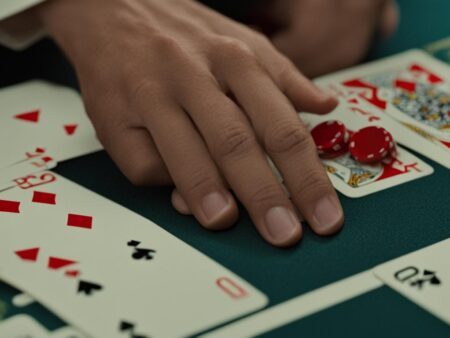Blackjack is a popular casino game worldwide, and mastering the 2 to 1 blackjack strategy can greatly increase your chances of winning. In this article, we will provide you with the ultimate winning strategies for 2 to 1 blackjack. We will cover the rules, basic strategy, betting systems, and tips to improve your gameplay. Whether you are a beginner or an experienced player, these strategies will maximize your wins and help you defeat the dealer’s edge.
Key Takeaways:
- Learn the rules of 2 to 1 blackjack to understand the gameplay.
- Memorize the basic strategy charts to make optimal decisions.
- Familiarize yourself with blackjack terms to make the right play in each situation.
- Explore advanced strategies like card counting to gain an edge over the casino.
- Practice, patience, and proper bankroll management are crucial for successful blackjack play.
The Basic Rules of Blackjack
Before diving into the strategies, it’s essential to understand the basic rules of blackjack. In this game, the goal is to beat the dealer’s hand without going over 21. Each player starts with two cards, and face cards are worth 10 points. An Ace can be worth either 1 or 11, depending on which value helps you create a better hand. You can hit (ask for another card) or stand (stick with your current hand). The dealer must hit until they reach a total of 17 or higher. Understanding these rules is crucial for implementing successful strategies.
The Basic Rules of Blackjack
To play blackjack, your objective is to have a hand value closer to 21 than the dealer’s hand, without exceeding 21. Here are the key rules to keep in mind:
- Each player is dealt two cards, and the dealer also receives two cards.
- Face cards (King, Queen, and Jack) are worth 10 points, and numerical cards are worth their face value. An Ace can be worth 1 or 11 points.
- You can request additional cards by hitting, trying to improve your hand’s value. However, if your hand exceeds 21, you automatically lose the round (known as going bust).
- If you are satisfied with your hand’s value, you can choose to stand and not receive any more cards.
- After all players have finished their rounds, the dealer will reveal their second card and follow specific rules for drawing additional cards. Typically, the dealer must hit (draw another card) until their hand reaches a total of 17 or higher.
- If your hand’s value is higher than the dealer’s without exceeding 21, you win the round and receive a payout. If the dealer’s hand value is higher or both hands have the same value, it results in a push (tie).
These rules provide the foundation for implementing various strategies and making informed decisions during gameplay. Knowing when to hit, stand, or double down relies on understanding the basic rules and evaluating the current situation at the blackjack table.
Defining Blackjack Terms
In order to effectively navigate the world of blackjack, it is essential to familiarize yourself with the terminology commonly used in the game. Understanding these terms will not only improve your overall understanding of blackjack, but it will also help you make the right decisions at critical moments. Here are some key blackjack terms that every player should know:
- Blackjack: A hand consisting of an ace and a card with a value of 10. It is the best possible hand in blackjack and typically pays out at a higher rate.
- Bust: Going over 21, resulting in an automatic loss for the player.
- Double Down: Placing an additional bet and receiving one more card. This move is typically made when the player believes their hand has a high chance of winning.
- Hard Hand: A hand that does not contain an ace or contains an ace that can only be considered as a 1.
- Hit: Asking for another card to be dealt to your hand.
- Insurance: A side bet that can be placed when the dealer shows an ace. It is a separate bet that pays out if the dealer has a blackjack.
- Push: When the player’s hand ties with the dealer’s hand, resulting in the bet being returned to the player without any winnings.
- Soft Hand: A hand that contains an ace that can be considered as either 1 or 11.
- Split: Separating a pair into two separate hands. This move is typically made when the player has a pair of cards with the same value.
- Stand: Choosing not to ask for another card and sticking with your current hand.
- Surrender: Giving up on your hand and forfeiting half of your initial bet.
By familiarizing yourself with these key blackjack terms, you will be equipped to make informed decisions and execute effective strategies at the blackjack table.
Glossary of Blackjack Terms
| Term | Definition |
|---|---|
| Blackjack | A hand consisting of an ace and a card with a value of 10. |
| Bust | Going over 21, resulting in an automatic loss for the player. |
| Double Down | Placing an additional bet and receiving one more card. |
| Hard Hand | A hand that does not contain an ace or contains an ace that can only be considered as a 1. |
| Hit | Asking for another card to be dealt to your hand. |
| Insurance | A side bet that can be placed when the dealer shows an ace. |
| Push | When the player’s hand ties with the dealer’s hand, resulting in the bet being returned to the player. |
| Soft Hand | A hand that contains an ace that can be considered as either 1 or 11. |
| Split | Separating a pair into two separate hands. |
| Stand | Choosing not to ask for another card and sticking with your current hand. |
| Surrender | Giving up on your hand and forfeiting half of your initial bet. |
With this glossary of blackjack terms, you can confidently delve into the world of blackjack armed with the knowledge of the game’s essential terminology. Understanding these terms will help you make informed decisions and navigate the blackjack table with confidence.
Blackjack Basic Strategy
When it comes to playing blackjack, having a solid strategy is essential to maximize your chances of winning. The basic strategy for blackjack provides players with the optimal play in each situation, based on probability theory and computer simulations. By following the basic strategy, you can minimize the house edge and increase your overall player return.
To effectively utilize the basic strategy, it is important to understand the different charts for hard hands, soft hands, and splitting pairs. These charts outline the best course of action for each combination of your hand and the dealer’s upcard. For example, if you have a hard 16 and the dealer’s upcard is a 7, the basic strategy chart will recommend hitting rather than standing.
Implementing the basic strategy requires practice and familiarity with the charts. It may seem counterintuitive at times, as it goes against gut instincts. However, by consistently following the basic strategy, you can make the most optimal decisions and improve your chances of winning in the long run. Remember, blackjack is a game of skill, and utilizing the basic strategy is an essential tool in your arsenal.
| Player’s Hand | Dealer’s Upcard | Optimal Play |
|---|---|---|
| Hard 12 | 4, 5, 6 | Stand |
| Soft 18 | 9, 10, Ace | Hit |
| Pair of 8s | Any | Split |
As you can see from the table above, the basic strategy provides specific recommendations for each player’s hand and the dealer’s upcard. Following these recommendations will give you the best statistical chance of winning. Keep in mind that the basic strategy is not a guaranteed way to win every hand, but it will significantly improve your overall gameplay and success rate.
Additional Rules
In addition to the basic strategy, there are some additional rules to keep in mind when playing blackjack. These rules can impact your gameplay and the decisions you make at the table.
Surrender in Blackjack
Surrendering is an option in some blackjack variations when you have a weak hand and the dealer has a strong upcard. It allows you to give up half of your bet and avoid playing out a hand that is likely to result in a loss. Surrendering can be a smart move when the odds are not in your favor.
Insurance in Blackjack
Insurance is another option available when the dealer shows an Ace as their upcard. Insurance is a side bet that the dealer has a blackjack (a total of 21). Despite its allure, insurance is generally not recommended as a long-term winning strategy. The probability of the dealer having a blackjack is relatively low, and the odds of winning the insurance bet are not favorable.
Even Money in Blackjack
Even money is an option when you have a blackjack (an Ace and a card with a value of 10) and the dealer shows an Ace as their upcard. It allows you to take an immediate payout of 1:1 instead of the usual 3:2 payout for a blackjack. While even money guarantees a win, it reduces the potential payout. In the long run, it is more profitable to decline even money and receive the higher payout for a blackjack.
| Options | Description |
|---|---|
| Surrender | Allows you to give up half of your bet and avoid playing out a losing hand. |
| Insurance | A side bet that the dealer has a blackjack. Generally not recommended. |
| Even Money | Immediate payout of 1:1 for a blackjack when the dealer shows an Ace. Often not the most profitable choice. |
Perfect Blackjack Strategy
When it comes to mastering blackjack, implementing the perfect blackjack strategy is essential. This advanced strategy takes into account various game variations and provides the most optimal plays for each situation. By following the perfect blackjack strategy charts, you can greatly improve your chances of winning and outsmarting the dealer.
The perfect blackjack strategy charts cover a wide range of scenarios, including hard hands, soft hands, and pairs. It guides you on when to hit, stand, double down, or split based on your hand and the dealer’s upcard. Whether you’re playing a single deck or multi-deck game, this strategy will help you make informed decisions and maximize your potential winnings.
By using the perfect blackjack strategy, you can significantly reduce the house edge and increase your overall player return. It is important to note that while this strategy provides the best play in each situation, it does not guarantee a win every time. Blackjack is still a game of chance, but with the perfect strategy, you can tilt the odds in your favor.
Remember to practice and familiarize yourself with the strategy charts to ensure you can make quick and accurate decisions during gameplay. With dedication and mastery of the perfect blackjack strategy, you can elevate your blackjack play to a whole new level and increase your chances of success at the tables.
Table: Perfect Blackjack Strategy
Note: The table image should be in the center, not on the left or right side.
Top 20 Blackjack Strategies

When it comes to mastering blackjack, having a repertoire of winning strategies is essential. Here, we present the top 20 blackjack strategies that will elevate your gameplay and help you achieve greater success at the tables.
1. Double Down on a Hard 11
When you have a hard 11, it’s advantageous to double down. This gives you the opportunity to maximize your potential winnings when the dealer is in a weak position.
2. Hit a Hard 12 if the Dealer’s Upcard is 2 or 3
If you have a hard 12 and the dealer’s upcard is a 2 or 3, hitting is the optimal strategy. This increases your chances of improving your hand without going over 21.
3. Never Split a Pair of 10s
While splitting pairs can often be beneficial, it is not recommended to split a pair of 10s. With a total of 20, you have a strong hand that is likely to beat the dealer.
4. Always Split a Pair of 8s
On the other hand, always split a pair of 8s. This gives you a chance to improve your hand and potentially create two winning hands instead of one.
| Strategy | Situation | Outcome |
|---|---|---|
| Double Down on a Hard 11 | Player’s hand: 11 / Dealer’s upcard: Any | Potential for a large win |
| Hit a Hard 12 if the Dealer’s Upcard is 2 or 3 | Player’s hand: 12 / Dealer’s upcard: 2 or 3 | Better chance of improving the hand |
| Never Split a Pair of 10s | Player’s hand: 10, 10 | Strong hand with high chances of winning |
| Always Split a Pair of 8s | Player’s hand: 8, 8 | Chance to improve the hand and create two winning hands |
These are just a few examples of the top blackjack strategies you can incorporate into your gameplay. Each strategy is designed to optimize your chances of winning based on different scenarios. By understanding and utilizing these strategies effectively, you can increase your overall success in blackjack.
“The key to success in blackjack lies in employing the right strategies at the right time. With these top 20 blackjack strategies, you’ll be well-equipped to make the most optimal decisions during gameplay and increase your chances of winning.”
Rules of Blackjack Variations
As we delve deeper into the world of blackjack, it’s important to explore the various blackjack variations that exist. Each variation brings its own unique set of rules and gameplay, offering players different opportunities and challenges. Understanding these variations is vital in adapting your strategies and maximizing your chances of winning.
One popular variation is Spanish 21, which is played with a Spanish deck of cards that excludes the 10s. This variation introduces bonus payouts for certain hands, such as a five-card 21 and a six-card 21. The absence of 10s affects the basic strategy, and players must adjust their gameplay accordingly to account for this difference.
Another intriguing variation is Pontoon, which originated in the United Kingdom. In Pontoon, both of the dealer’s cards are dealt face down, adding an element of mystery to the game. Additionally, the terms used in Pontoon differ from traditional blackjack, with “twist” instead of “hit” and “stick” instead of “stand.” Understanding these unique rules is crucial for mastering Pontoon and maximizing your wins.
One more notable variation is Double Exposure, also known as Dealer Disclosure. In this variation, both of the dealer’s cards are dealt face up, giving players valuable information to make strategic decisions. However, to compensate for this advantage, the natural blackjack pays even money instead of the standard 3 to 2 payout. It’s important to consider this difference when playing Double Exposure to adjust your betting and gameplay strategies.
By familiarizing yourself with these and other variations, you can expand your blackjack repertoire and adapt your strategies to different games. Remember that each variation may have its own distinct rules, and understanding these nuances is the key to success. Now that we have explored the rules of blackjack variations, let’s move on to more advanced strategies that can elevate your gameplay to the next level.
The Martingale System

The Martingale System is a well-known and widely used betting system in the world of blackjack. It is a negative progression system that involves doubling your bet after each loss in the hopes of recouping your losses and making a profit. The idea behind the Martingale System is that eventually, you will win and the wins will be large enough to cover the losses incurred during the losing streaks.
However, it is important to note that the Martingale System comes with its own set of risks. While it can be effective in theory, it requires a significant bankroll to withstand long losing streaks. The system assumes that you have an unlimited amount of money to continue doubling your bets, but in reality, most players have limits to their bankrolls.
Additionally, casinos have implemented table limits to prevent players from using the Martingale System indefinitely. These limits can restrict the amount of money you can bet and ultimately limit the effectiveness of the system. It is also worth considering that the Martingale System does not guarantee a win, as each hand in blackjack is independent of the previous ones.
Table: Pros and Cons of the Martingale System
| Pros | Cons |
|---|---|
| – Can result in large wins | – Requires a significant bankroll |
| – Simple to understand and implement | – Casinos have table limits |
| – Can offset losses in the short term | – Does not guarantee a win |
While the Martingale System can be appealing and has the potential for big wins, it is crucial to approach it with caution and a clear understanding of the risks involved. Proper bankroll management is essential when using this system, and it is important to set limits to prevent significant losses. It is also recommended to combine the Martingale System with other blackjack strategies to increase your chances of success.
Winning Streak Strategies
When it comes to blackjack, capitalizing on a winning streak can lead to substantial profits. Having a solid strategy in place during a winning streak is essential to make the most out of this fortunate situation. In this section, we will explore some winning streak strategies, also known as positive progression systems, that can help you maximize your winnings and minimize potential losses.
Positive progression systems involve increasing your bet size after a winning hand. This strategy aims to take advantage of a hot streak and amplify your profits. However, it’s crucial to set a stopping point to lock in your winnings and avoid risking everything on a potential losing hand.
One popular winning streak strategy is the Paroli system. With this strategy, you double your bet after each win, allowing your profits to accumulate rapidly. The key is to determine a desired number of consecutive wins and then reset your bet size to the initial amount after reaching that goal. This way, you secure your winnings and start fresh with a lower risk.
Another winning streak strategy is the Reverse Martingale system. Contrary to the traditional Martingale system, which doubles your bet after a loss, the Reverse Martingale system doubles your bet after a win. By doing so, you aim to ride the wave of success and increase your winnings exponentially. However, it’s crucial to establish a stopping point to preserve your profits and prevent potential losses from erasing your gains.
Table: Winning Streak Strategies
| Strategy | Description |
|---|---|
| Paroli System | Double your bet after each win and reset to the initial bet size after reaching a desired number of consecutive wins. |
| Reverse Martingale System | Double your bet after each win to capitalize on a winning streak. Set a stopping point to secure your profits. |
It’s important to note that winning streak strategies can be risky if not executed with caution. It’s crucial to have a clear plan in place, establish stopping points, and manage your bankroll wisely. Additionally, it’s essential to remember that blackjack is a game of chance, and even the most effective strategies cannot guarantee consistent wins. However, by incorporating winning streak strategies into your gameplay, you can enhance your chances of profiting from a fortunate streak.
Oscar’s Grind Strategy
The Oscar’s Grind strategy is a positive progression betting system that can be utilized in blackjack to maximize winnings. This strategy focuses on gradually increasing the bet size after each win, while keeping the bet size the same after a loss. The goal is to win one betting unit per series and start a new series with the original bet size. By employing this strategy, players aim to take advantage of winning streaks and minimize losses during losing streaks.
With Oscar’s Grind, the key is to have patience and discipline. It is important to stick to the predetermined betting sequence and not deviate from it, regardless of the outcome of each hand. By maintaining a consistent approach, players can avoid impulsive decisions and protect their bankroll.
While Oscar’s Grind can be effective in the long run, it is crucial to have a sufficient bankroll to withstand potential losing streaks. It is also essential to set a stop-loss limit to prevent significant losses. This strategy requires a strategic mindset and careful monitoring of wins and losses.
| Bet Size | Result | Net Gain/Loss |
|---|---|---|
| 1 | Win | +1 |
| 1 | Loss | 0 |
| 2 | Win | +2 |
| 2 | Win | +4 |
| 2 | Loss | +2 |
| 3 | Win | +5 |
| 3 | Loss | +2 |
| 4 | Win | +6 |
| 4 | Win | +10 |
| 4 | Win | +14 |
| 4 | Loss | +10 |
The Oscar’s Grind strategy is a calculated approach to blackjack betting. By gradually increasing bets after wins, players can capitalize on winning streaks and minimize losses during losing streaks. However, it is important to have a sufficient bankroll and set a stop-loss limit to protect against significant losses. Patience, discipline, and careful monitoring of wins and losses are key to successfully implementing this strategy.
Counting Cards
One of the most advanced blackjack strategies is card counting. Contrary to popular belief, card counting is not about memorizing every card that has been played. Instead, it involves keeping track of the ratio between high cards (e.g., 10s, face cards, and Aces) and low cards (e.g., 2s, 3s, 4s, 5s, and 6s) that are still in the deck. By monitoring this ratio, players can determine when the remaining deck is favorable to them or the dealer.
Card counting enables players to make more informed decisions, such as adjusting their bet sizes and altering their playing strategies based on the current card composition. When the deck is rich in high cards, players have a higher probability of getting blackjack (a natural 21) and winning double their bet. On the other hand, when the deck is rich in low cards, players are more likely to bust (go over 21) and lose their bets.
It’s important to note that card counting is not illegal, but it is frowned upon by casinos. While they cannot deny players from using their minds to enhance their gameplay, casinos have the right to refuse service to anyone they suspect of card counting. Therefore, it is crucial for card counters to employ stealth and camouflage techniques to avoid detection. These techniques include betting irregularly, acting like a recreational player, and avoiding excessive winning streaks.
Card Counting Systems
There are several card counting systems available, each with its own level of complexity and accuracy. One of the most well-known systems is the Hi-Lo Count, which assigns a value of +1 to low cards and -1 to high cards. The player keeps a running count of these values throughout the game to estimate the deck’s composition. Other popular card counting systems include the KO Count, the Hi-Opt I Count, and the Omega II Count.
It’s important to choose a card counting system that suits your skill level and playing style. Beginners may find simpler systems like the Hi-Lo Count easier to grasp, while more experienced players might opt for more advanced systems for increased accuracy. Whichever system you choose, remember that card counting requires practice, discipline, and a keen eye for detail.
Conclusion
In conclusion, our ultimate winning strategies for 2 to 1 blackjack can greatly improve your chances of success in this popular casino game. By mastering the basic rules of blackjack, understanding key terms, and implementing the basic strategy, you can minimize the house edge and maximize your player return. Additionally, by exploring advanced strategies, such as perfect blackjack strategy and top 20 blackjack strategies, you can further enhance your gameplay.
It is important to note that blackjack is ultimately a game of chance, and luck plays a role in determining the outcome. However, by practicing patience, utilizing proper bankroll management, and applying these proven strategies, you can increase your odds of winning. Remember to always play responsibly and within your means.
We hope that this comprehensive guide has provided you with valuable insights into the world of 2 to 1 blackjack. By following our strategies, you can take your gameplay to the next level and enjoy the thrill of defeating the dealer’s edge. Good luck and may your cards be in your favor!
FAQ
What is blackjack?
Blackjack is a popular casino game where the goal is to beat the dealer’s hand without going over 21.
What are the basic rules of blackjack?
Each player starts with two cards, and face cards are worth 10 points. An Ace can be worth either 1 or 11. Players can ask for additional cards (hit) or stick with their current hand (stand). The dealer must hit until they reach a total of 17 or higher.
What is the basic strategy in blackjack?
The basic strategy provides the best play in each situation and is determined using probability theory. By following the basic strategy charts, players can make optimal decisions and minimize the house edge.
Are there any additional rules in blackjack?
Yes, surrendering is an option in some casinos when you have a weak hand and the dealer has a strong upcard. Insurance is another option when the dealer shows an ace, but it is generally not recommended based on probability.
What are some advanced strategies in blackjack?
Advanced strategies include perfect blackjack strategy, which takes into account specific game variations, and counting cards, which involves keeping track of played cards to gain an edge over the casino.
What are some popular blackjack variations?
Some popular variations include Spanish 21, Pontoon, and Double Exposure. Each variation introduces unique rules that can affect your strategy and gameplay.
What is the Martingale System?
The Martingale System is a betting strategy that involves doubling the bet after each loss to offset losing streaks.
What are winning streak strategies?
Winning streak strategies focus on increasing the bet after a winning hand to maximize profits. It is important to set a stopping point during a winning streak to secure your winnings.
What is Oscar’s Grind Strategy?
Oscar’s Grind is a betting strategy that involves keeping the bet size the same after a loss and increasing it by one after each win to win one betting unit per series.
What is card counting?
Card counting is a technique used by advanced players to keep track of played cards and determine whether the remaining cards are favorable or unfavorable to the player.







